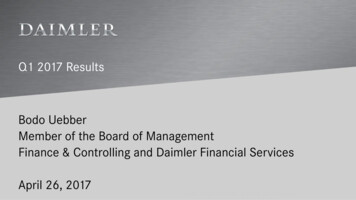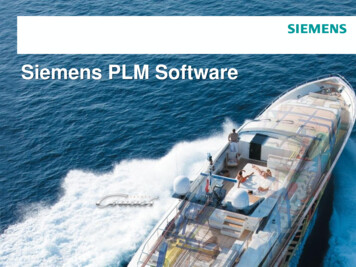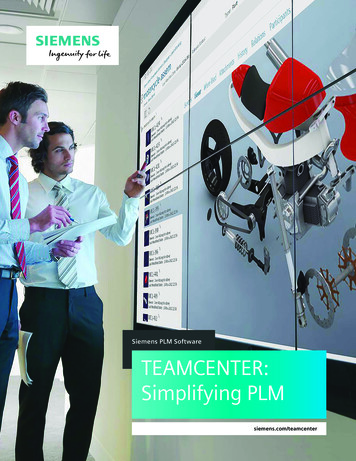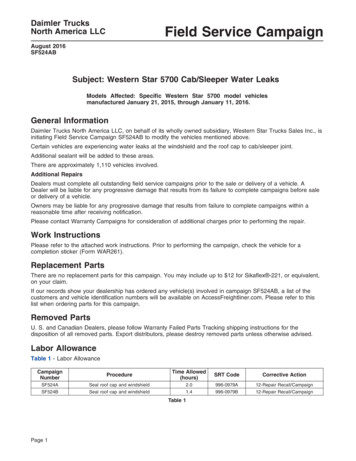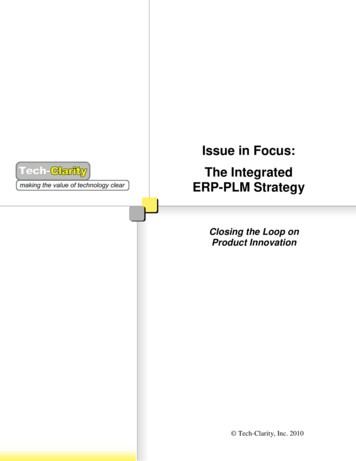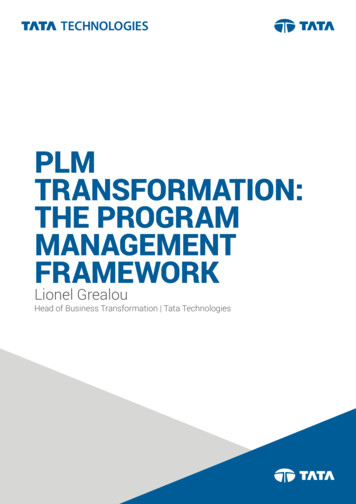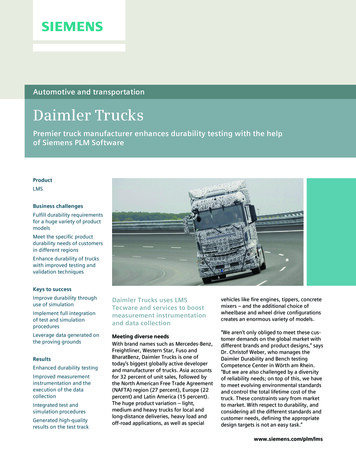
Transcription
Automotive and transportationDaimler TrucksPremier truck manufacturer enhances durability testing with the helpof Siemens PLM SoftwareProductLMSBusiness challengesFulfill durability requirementsfor a huge variety of productmodelsMeet the specific productdurability needs of customersin different regionsEnhance durability of truckswith improved testing andvalidation techniquesKeys to successImprove durability throughuse of simulationImplement full integrationof test and simulationproceduresLeverage data generated onthe proving groundsResultsEnhanced durability testingImproved measurementinstrumentation and theexecution of the datacollectionIntegrated test andsimulation proceduresGenerated high-qualityresults on the test trackDaimler Trucks uses LMSTecware and services to boostmeasurement instrumentationand data collectionvehicles like fire engines, tippers, concretemixers – and the additional choice ofwheelbase and wheel drive configurationscreates an enormous variety of models.Meeting diverse needsWith brand names such as Mercedes-Benz,Freightliner, Western Star, Fuso andBharatBenz, Daimler Trucks is one oftoday’s biggest globally active developerand manufacturer of trucks. Asia accountsfor 32 percent of unit sales, followed bythe North American Free Trade Agreement(NAFTA) region (27 percent), Europe (22percent) and Latin America (15 percent).The huge product variation – light,medium and heavy trucks for local andlong-distance deliveries, heavy load andoff-road applications, as well as special“We aren’t only obliged to meet these customer demands on the global market withdifferent brands and product designs,” saysDr. Christof Weber, who manages theDaimler Durability and Bench testingCompetence Center in Wörth am Rhein.“But we are also challenged by a diversityof reliability needs; on top of this, we haveto meet evolving environmental standardsand control the total lifetime cost of thetruck. These constraints vary from marketto market. With respect to durability, andconsidering all the different standards andcustomer needs, defining the appropriatedesign targets is not an easy task.”www.siemens.com/plm/lms
Durability is keyThe critical question for durability engineers is always the total cost of ownershipof a truck, so the added value of durabilityengineering is very clear.“Durability defines the long-term perception of the product, radiating reliabilityand robustness, and also dictates theresidual value of a truck on the secondhand market,” says Weber. “Next to this, atruck needs to be absolutely safe under allconditions.”Truck durability standards are much moredemanding than for those of a passengercar, and also differ from market to market.“Mercedes-Benz cars are designed to withstand 300,000 kilometers (km) withoutmajor repairs,” says Weber. “Long-haulstandard trucks are designed to last1,200,000 km. Of course, harsher environmental conditions, more overload andmore dynamic driving will shorten the lifeexpectancy of the truck.“For example, in Brazil, the same standard,unreinforced trucks will only last 900,000km. But at the same time, we know of 30and even 40-year-old trucks that are still indaily use. You might have to change theengine or the axles, but as a backbone, thechassis should never break.”Daimler Truck’s durability testing andvalidation procedures are very customerusage oriented: “We call it applicationspecific testing,” Weber says. “It’s basedon customer usage profiles, marketintelligence and expectations, and fieldmeasurements from all over the world.Siemens PLM Software is our partner in thebusiness of retrieving all this information.We also do measurements together withcustomers in their specific applications.That way we learn how a truck is used on aday-to-day basis.”The usage intelligence gained from thesecustomer trials is linked to each cell of theapplication matrix, and varied by putting ascatter of distribution over the parameters.“ We very much appreciate the collaborationwith Siemens PLM Software, especially thefully integrated service offered. It is not onlyabout evaluating data; when needed,Siemens PLM Software can provide us withthe full line of services.”Dr. Christof WeberDaimler Durability and Bench testing Competence CenterDaimler Trucks
“By adopting these statistical methods, weare able to simulate more or less 100,000different customers for each applicationcell,” Weber says. “With this enriched application matrix, we can define design targetsfor truck applications throughout theworld.“Working on durability starts with simulation. We try to get as much work done inthe low-cost areas early in the development process by means of simulation andlimiting the amount of field tests as muchas possible. Simulation accuracy is assuredby conducting specific tests and constantfeedback loops between test and simulation. Of course, this approach necessitatesthe full integration of simulation and testprocedures.”Testing all variants would be far too costlyand time consuming; therefore, a specificvehicle combination is selected to represent an entire platform range. Only thisone vehicle will undergo a rig test or acomplete road test.“If you are able to map the mutual influences for different systems in a truck, youautomatically know how many variantsyou need to test,” says Weber. “The truckselection is based on targeted simulationand long-term engineering experiences.The design of experiments (DOE) is a veryhelpful tool. It lets you estimate how different components will interact and howthis will affect the truck’s overalldurability.”Understanding specific marketrequirementsProving grounds play a key part in the rollout of Daimler Trucks’ application-specifictesting philosophy. The 2007 state-of-theart proving ground in Wörth am Rhein ispart of the Development and Test Centerat the Mercedes-Benz Wörth plant, thelargest commercial vehicle plantworldwide.The new 550,000 square-meter provingground is designed to recreate a relevantset of road and terrain conditions fromaround the world. The outside test lanesinclude grades of up to 26 degrees. Theselanes are used for function testing, such asbrake tests. The inside area features a fullvariety of rough-terrain tracks, with 14 different types of road surfaces covering theentire spectrum of world road conditions,from highway to dirt road. Test drivers areassisted by a global positioning system(GPS) that helps them to perform repeatedtest routines consistently while adheringto the engineers’ instructions.
“Working on durability startswith simulation. We try to getas much work done in the lowcost areas early in the development process by means ofsimulation and limiting theamount of field tests as muchas possible. Simulation accuracy is assured by conductingspecific tests and constantfeedback loops between testand simulation. Of course, thisapproach necessitates the fullintegration of simulation andtest procedures.”Dr. Christof WeberDaimler Durability and BenchTesting Competence CenterDaimler Trucks“By cleverly combining customer profileswith specific track characteristics, we’reable to design a durability test track program profile that accurately represents aspecific market requirement,” says Weber.“It’s basically a very simple idea, yet itrequires a complex manipulation of data,which you have to translate into a test program, telling the test driver exactly howmany times and at what speed he has todrive different circuit sections, representing, for instance, the application profile ofa Brazilian customer.”For the test driver, it is not so easy to keepall these parameters in mind while driving;therefore, every test vehicle at the Wörthtest track is controlled with a GPS. Thisallows the test engineer to remotely checkif the driver performs according to thebrief. A cockpit display informs the driverabout his actual and target speed, andpossible tolerances. The driver can also bewarned through acoustical feedback.Daimler recently inaugurated its newstate-of-the-art production facility inOragadam, India. The site also houses anintegrated research and development center and test track. The facility will producelight to heavy BharatBenz trucks from thethird quarter of 2012. The Indian testfacility is spread across approximately19 hectares and has two different tracks.The three-lane outer track has a totallength of 1.55 km and is specially designedfor testing the power train and drivingnoise. The two-lane inner track is 1.16 kmlong and includes a variety of poor roadfeatures specific to India. The track alsooffers special testing opportunities, including a water trough, a dusty road and poorroad surfaces. Facilities for testing ongrades and steering will be added in thenear future.
Solutions/ServicesLMS Tecwarewww.siemens.com/plm/lms-tecwareLMS omer’s primary businessDaimler Trucks develops andproduces vehicles in a globalnetwork under the brands ofMercedes-Benz, Freightliner,Western Star, Fuso andBharatBenz. It the biggestglobally active manufacturerof trucks above six metric tonsgross vehicle weight, andhas 27 production facilitiesaround the er-trucksCustomer locationStuttgartGermanyForging a strong collaborationThe Durability and Bench Testing department of Daimler Trucks and Siemens PLMSoftware work together very intensively.“At first we called them to support us,”Weber says. “But this has developed into astrategic partnership: Siemens PLMSoftware equips our test vehicles withstate-of the art sensors and measurementequipment. Strain gauging according toindustry standards is an important part ofthis. Excellence both in measurementinstrumentation and in the execution ofthe data collection are our absolutepriority.“Measurement campaigns on provingground and in the field are also performedtogether with the LMS Engineering teamsand a Daimler test engineer. The LMSTecWare software tool has become anintegral part of our everyday operation.Generating high-quality test results iscritical.“We very much appreciate the collaboration with Siemens PLM Software, especially the fully integrated service offered.It is not only about evaluating data; whenneeded, Siemens PLM Software can provide us with the full line of services.”“The LMS TecWare software tool has becomean integral part of our everyday operation.Generating high-quality test results is critical.”Dr. Christof WeberDaimler Durability and Bench testing Competence CenterDaimler TrucksSiemens PLM SoftwareAmericasEuropeAsia-Pacific 1 248 952 5664 32 16 384 200 852 2230 3308www.siemens.com/plm 2014 Siemens Product Lifecycle Management Software Inc. Siemens and the Siemens logo are registered trademarks ofSiemens AG. LMS, LMS Imagine.Lab, LMS Imagine.Lab Amesim, LMS Virtual.Lab, LMS Samtech, LMS Samtech Caesam,LMS Samtech Samcef, LMS Test.Lab, LMS Soundbrush, LMS Smart and LMS SCADAS are trademarks or registered trademarksof LMS International N.V. or any of its affiliates. All other trademarks, registered trademarks or service marks belong toheir respective holders.Z3 36429 3/14 A
TecWare software tool has become an integral part of our everyday operation. Generating high-quality test results is critical. "We very much appreciate the collabora-tion with Siemens PLM Software, espe-cially the fully integrated service offered. It is not only about evaluating data; when needed, Siemens PLM Software can pro-

